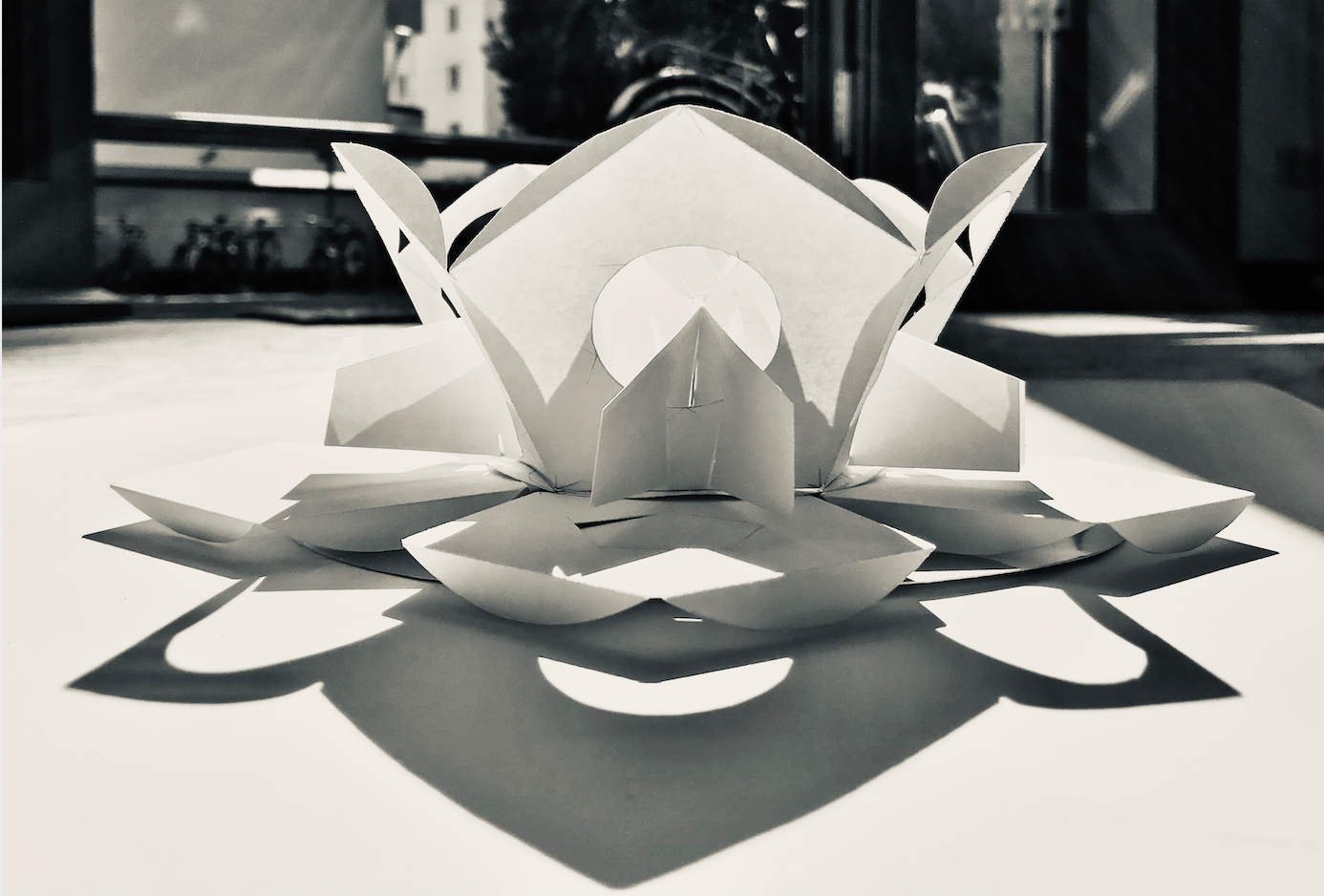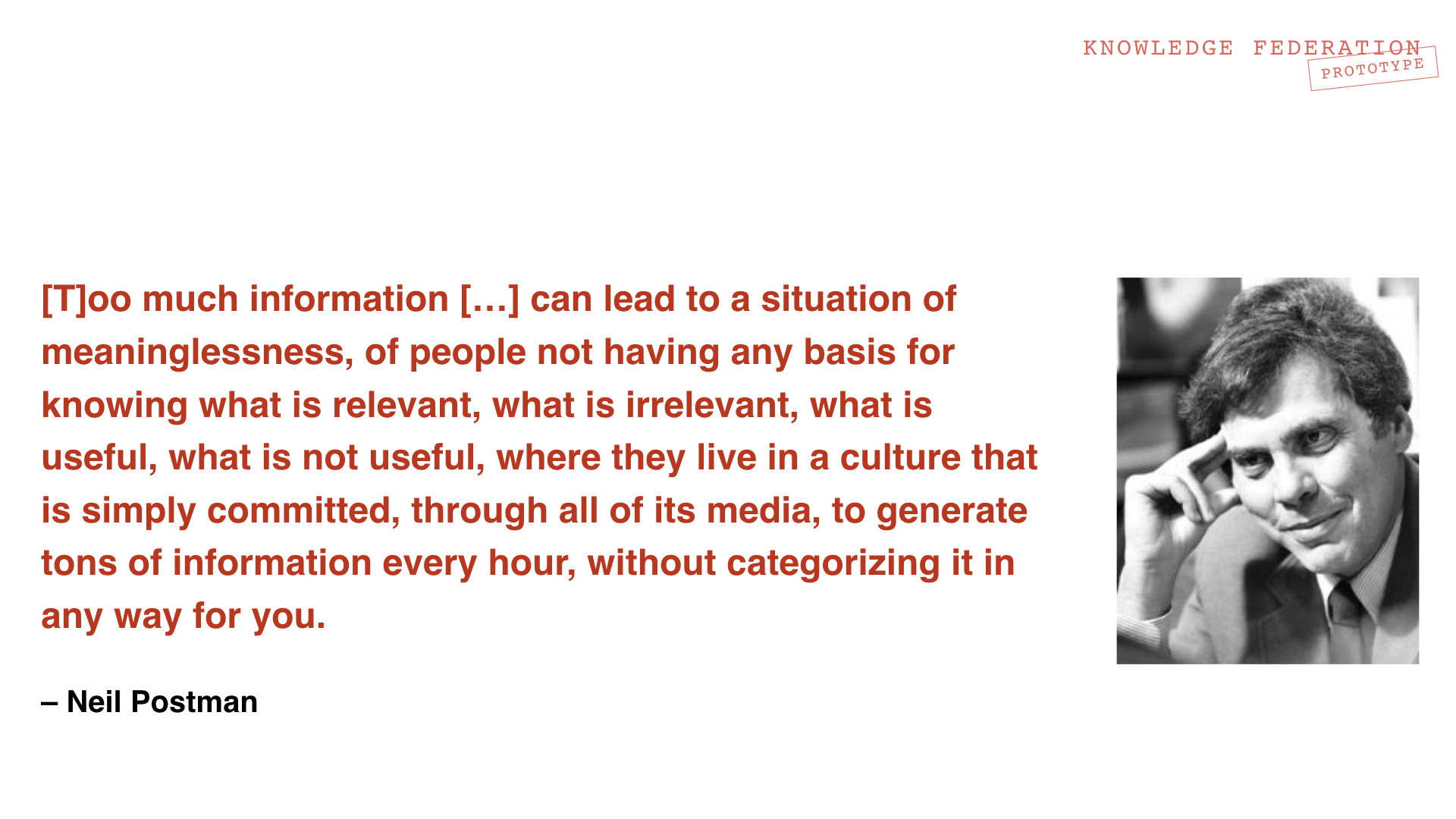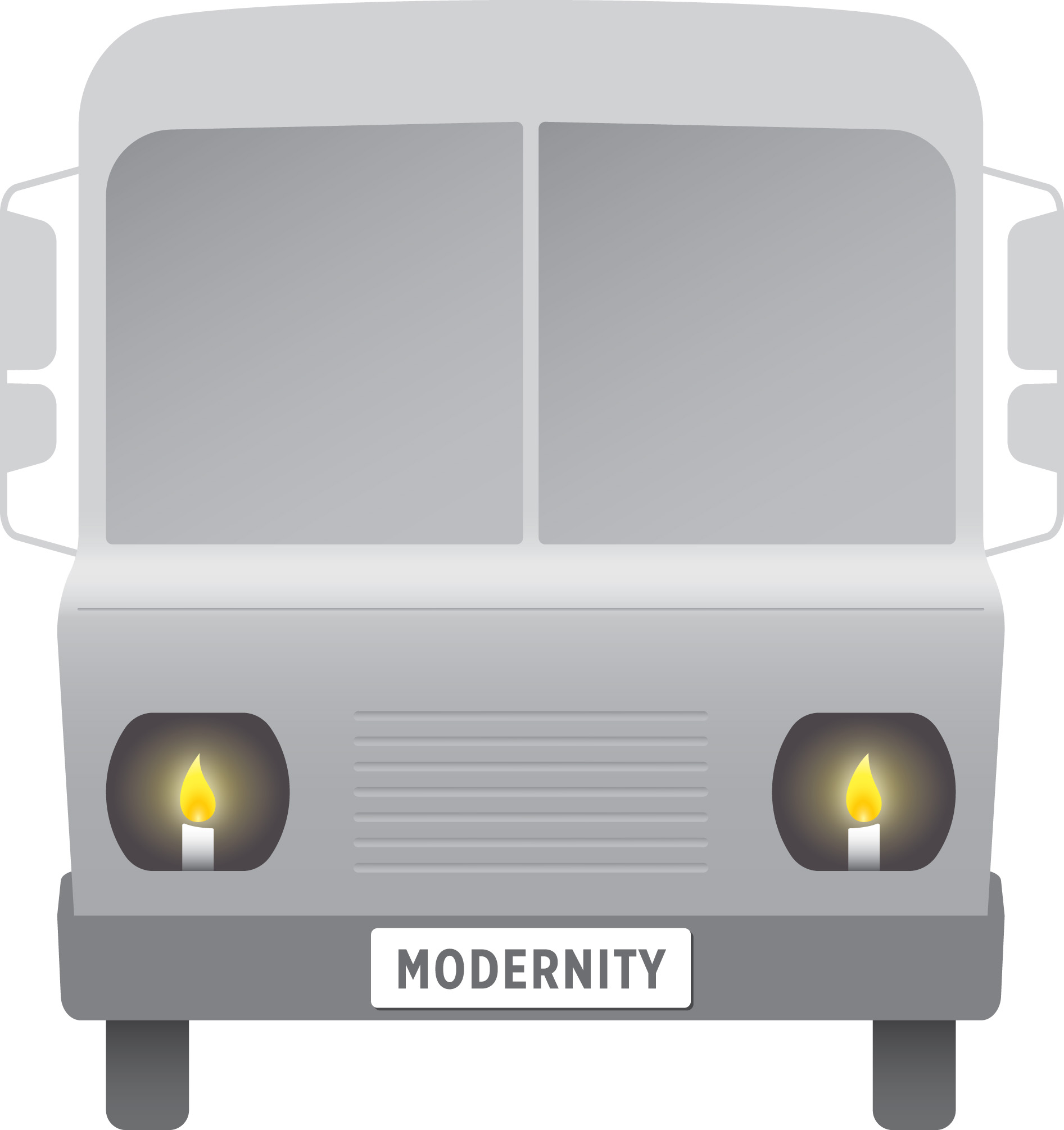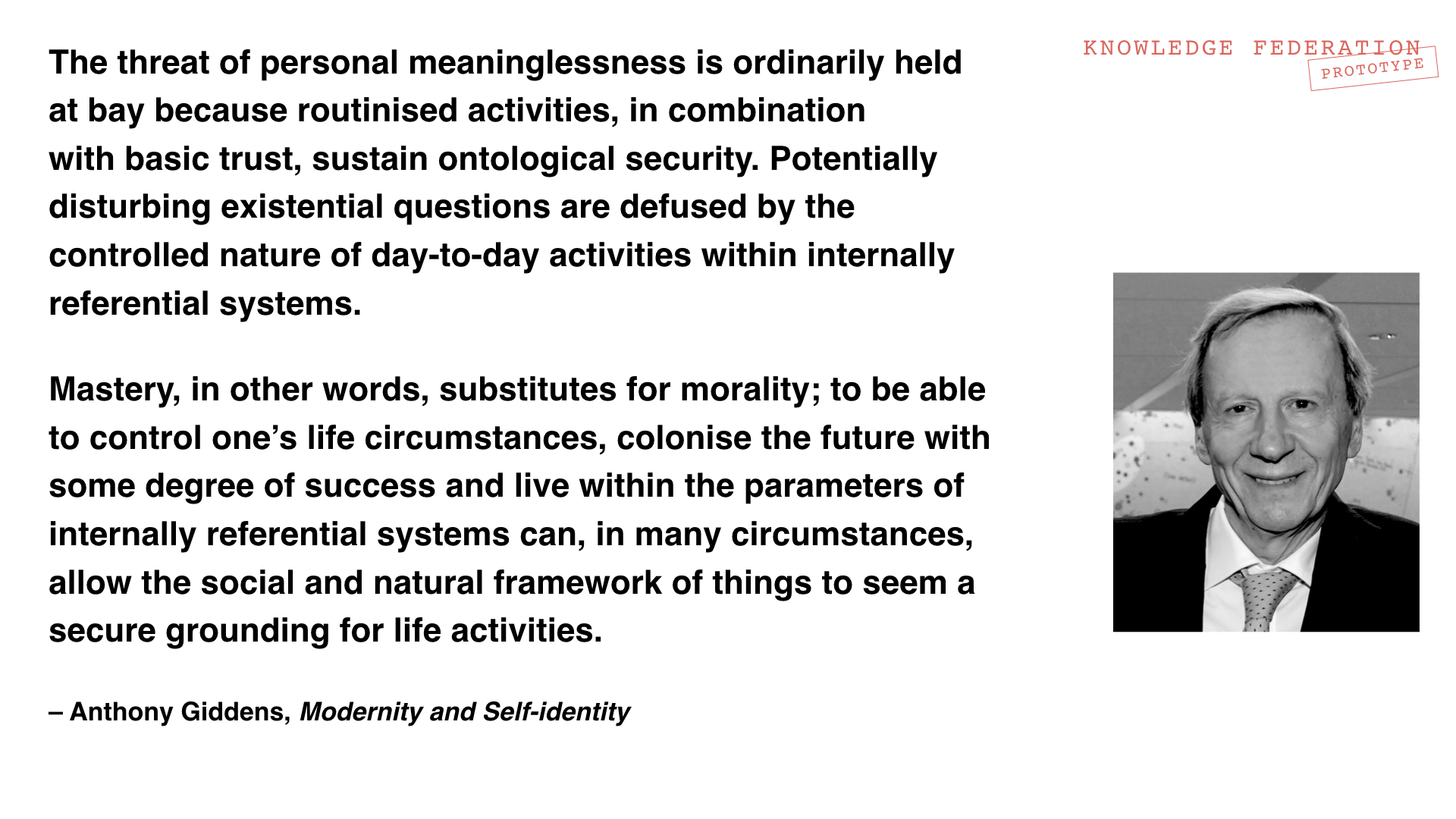Difference between revisions of "Holotopia"
m |
|||
| Line 2: | Line 2: | ||
<div class="row"> | <div class="row"> | ||
| − | <div class="col-md-3"><h3>Modernity needs the lightbulb | + | <div class="col-md-3"><h3>Modernity needs the lightbulb</h3></div> |
<div class="col-md-7"> | <div class="col-md-7"> | ||
[[File:Postman-meaning.jpeg]] | [[File:Postman-meaning.jpeg]] | ||
| − | <p>Already in the 1990, when Tim Berners Lee was | + | <p>Already in the 1990, at the point when Tim Berners Lee was writing the code for the World Wide Web, the NYU communications scholar Neil Postman was warning us that our habitual massive outpouring of information has the <em>opposite</em> effect than the one intended—that it not only leaves us uninformed, but that it damages our very <em>sense</em> of meaning, our very <em>capability</em> to make sense.</p> |
</div> </div> | </div> </div> | ||
| Line 11: | Line 11: | ||
<div class="col-md-3"></div> | <div class="col-md-3"></div> | ||
<div class="col-md-6"> | <div class="col-md-6"> | ||
| − | <p> | + | <p>Imagine a world where information is treated as other human-made things—where information and the ways it's handled are adapted to the core purposes that need to be served. What would information be like? By what methods, in what way and by whom would it be created? What new information formats, new <em>kinds</em> of information would emerge? In what way would our public informing be different? What would academic communication be like? By creating our Knowledge Federation <em>prototype</em>, we provided an academically coherent answer to those and various other related questions—answers that are not only described and explained, but also already implemented in actual, real-life embedded <em>prototypes</em>.</p> |
| − | |||
| − | < | ||
| − | |||
</div> | </div> | ||
<div class="col-md-3"> | <div class="col-md-3"> | ||
| Line 20: | Line 17: | ||
<small>The Modernity <em>ideogram</em> depicts our civilization as a bus, and our way of handling information as its candle headlights.</small> | <small>The Modernity <em>ideogram</em> depicts our civilization as a bus, and our way of handling information as its candle headlights.</small> | ||
</div> </div> | </div> </div> | ||
| − | |||
| − | |||
| − | |||
| − | |||
| − | |||
| − | |||
| − | |||
| − | |||
| − | |||
<div class="row"> | <div class="row"> | ||
| − | <div class="col-md-3">< | + | <div class="col-md-3"><h3>Modernity needs the lightbulb</h3></div> |
<div class="col-md-7"> | <div class="col-md-7"> | ||
| − | + | <p>But having done that, we are compelled to concede that what we are facing is not a problem but a paradox—the same paradox that the giants on whose shoulders we stood to create our <em>prototype</em> had to face, and were unable to overcome. | |
| − | <p> | ||
| − | |||
| − | |||
| − | |||
| − | |||
| − | |||
| − | |||
| − | |||
</p> | </p> | ||
| + | [[File:Giddens-OS.jpeg]] | ||
| + | <p>In the world where we all have been socialized to "mind our own business" and <em>publish more</em>, as scientists, and as journalists, because that's what we are paid for, and what our careers and our institutions depend on—there is no established way, no institution, and not even the will to make the kind of changes that would make information once again serve the social purposes that need to be served.</p> | ||
| + | <p>A purpose of the Holotopia <em>prototype</em>, which is currently under development, is to overcome that obstacle.</p> | ||
| + | <p>What would our world be like, if all our overabundant knowledge were used to give us the kind of meaning we need? And where we <em>used</em> this meaning, to orient our handling, of all things that matter? The goal of the Holotopia project is to answer that question not only in principle, not only on paper, but to implement it in...</p> | ||
</div> </div> | </div> </div> | ||
<div class="row"> | <div class="row"> | ||
| − | <div class="col-md-3"><h4> | + | <div class="col-md-3"><h4>How to change course</h4></div> |
<div class="col-md-7"> | <div class="col-md-7"> | ||
| − | |||
| − | |||
[[File:Peccei-Future.jpeg]] | [[File:Peccei-Future.jpeg]] | ||
| − | < | + | <p>Based on a decade of The Club of Rome's research into the future prospects of mankind, [[Holotopia: Aurelio Peccei|Aurelio Peccei]] diagnosed that the humanity is on a collision course with nature. We take his diagnoses as a challenge, and as a natural benchmark test for our project. Can the new 'headlights' we are proposing help us "change course"? And if they can—<em>what will the new course be</em>?</p> |
| − | |||
</div> </div> | </div> </div> | ||
| Line 57: | Line 38: | ||
<div class="col-md-3"><h4>A vision</h4></div> | <div class="col-md-3"><h4>A vision</h4></div> | ||
<div class="col-md-7"> | <div class="col-md-7"> | ||
| − | |||
| − | |||
<p>As a vision of a possible future, the <em>holotopia</em> is a positive answer to the question posited in the Holoscope.org's opening: | <p>As a vision of a possible future, the <em>holotopia</em> is a positive answer to the question posited in the Holoscope.org's opening: | ||
<blockquote> | <blockquote> | ||
| Line 218: | Line 197: | ||
| − | <!-- | + | <!-- CLIPPINGS |
| + | |||
| + | #1 | ||
| + | |||
| + | |||
| + | <div class="row"> | ||
| + | <div class="col-md-3"><h4>Seeing things whole</h4></div> | ||
| + | <div class="col-md-7"> | ||
| + | [[File:Holoscope.jpeg]] | ||
| + | <p>We here refer to the proposed approach to knowledge by its pseudonym [[Holotopia: Holoscope|<em>holoscope</em>]], to points to its distinguishing characteristic—namely that it allows us to combine disparate pieces of information together, and show a theme or an issue from all sides. So that we may see it as a whole. | ||
| + | <blockquote> | ||
| + | Science gave us new ways to look at the world, and our vision expanded beyond bounds. The telescope and the microscope enabled us to see the things that were too distant or too small to be seen by the naked eye. At the same time, science had the tendency to keep us focused on things that were either too distant or too small to be relevant – compared to all those big things right in front of our eyes, which now demand our attention. The <em>holoscope</em> is conceived as way to look at the world that helps us see any chosen thing or theme as a whole – from all sides; and in correct proportions. | ||
| + | </blockquote> | ||
| + | </p> | ||
| + | [[File:Perspective-S.jpg]] | ||
| + | <small>A purpose of the <em>holoscope</em> is to illuminate what has remained hidden, so that we may see the whole in correct shape and proportions.</small> | ||
| + | <p> A complete model (or technically a [[Holotopia: Prototype|<em>prototype</em>]]) of the [[Holotopia: Holoscope|<em>holoscope</em>]] having been described on Holoscope.org, and explained in a variety of ways on Holoscope.info, it remains to provide a proof of concept application. We present the <em>holotopia</em> as an answer to the question "What difference might the <em>holoscope</em> make?" | ||
| + | </p> | ||
| + | </div> </div> | ||
| + | |||
| + | #2 | ||
| + | |||
| + | [[File:Invisible Elephant.jpg]] | ||
| + | <small><center>There is an <em>elephant</em> in the room, ready to be seen as soon as we connect the dots. Before we saw it, we heard our leading thinkers talk about "the hoze", "the fan" and "the trunk"—but they didn't make sense, and we ignored them. The vision of the emerging <em>paradigm</em> empowers us to put good insights to good use.</center></small> | ||
| + | |||
| + | #3 | ||
| + | |||
| + | |||
| + | |||
| + | |||
| + | |||
| + | |||
| + | |||
| + | |||
| + | |||
| + | |||
Revision as of 04:14, 23 March 2020
Contents
Holotopia
Modernity needs the lightbulb
Already in the 1990, at the point when Tim Berners Lee was writing the code for the World Wide Web, the NYU communications scholar Neil Postman was warning us that our habitual massive outpouring of information has the opposite effect than the one intended—that it not only leaves us uninformed, but that it damages our very sense of meaning, our very capability to make sense.
Imagine a world where information is treated as other human-made things—where information and the ways it's handled are adapted to the core purposes that need to be served. What would information be like? By what methods, in what way and by whom would it be created? What new information formats, new kinds of information would emerge? In what way would our public informing be different? What would academic communication be like? By creating our Knowledge Federation prototype, we provided an academically coherent answer to those and various other related questions—answers that are not only described and explained, but also already implemented in actual, real-life embedded prototypes.
Modernity needs the lightbulb
But having done that, we are compelled to concede that what we are facing is not a problem but a paradox—the same paradox that the giants on whose shoulders we stood to create our prototype had to face, and were unable to overcome.
In the world where we all have been socialized to "mind our own business" and publish more, as scientists, and as journalists, because that's what we are paid for, and what our careers and our institutions depend on—there is no established way, no institution, and not even the will to make the kind of changes that would make information once again serve the social purposes that need to be served.
A purpose of the Holotopia prototype, which is currently under development, is to overcome that obstacle.
What would our world be like, if all our overabundant knowledge were used to give us the kind of meaning we need? And where we used this meaning, to orient our handling, of all things that matter? The goal of the Holotopia project is to answer that question not only in principle, not only on paper, but to implement it in...
How to change course
Based on a decade of The Club of Rome's research into the future prospects of mankind, Aurelio Peccei diagnosed that the humanity is on a collision course with nature. We take his diagnoses as a challenge, and as a natural benchmark test for our project. Can the new 'headlights' we are proposing help us "change course"? And if they can—what will the new course be?
A vision
As a vision of a possible future, the holotopia is a positive answer to the question posited in the Holoscope.org's opening:
Think about the world at the twilight of the Middle Ages and the dawn of the Renaissance: devastating religious wars, terrifying epidemics… Think of the scholastics pondering about the angels dancing on a needlepoint; and Galilei in house arrest, whispering “and yet it moves” into his beard. Observe that the problems of the epoch were not resolved by focusing on those problems, but by a slow and steady development of an entirely new approach to knowledge. Several centuries of comprehensive evolution followed. Could a similar advent be in store for us today?
Just as the case was in Galilei's time, a new order of things or technically a paradigm is ready to emerge.
The holotopia is more desirable future than the common utopias. Yet it is fully realizable. We already own the knowledge needed for its fulfillment. We only need to put it together; and put it to use.
The five insights
The holotopia vision is made concrete or federated in terms of five insights:
- The Convenience Paradox insight points to a revolution in "pursuit of happiness" and in culture, similar to the Renaissance
- The Power Structure insight points to a revolution in innovation, on the scale of the Industrial Revolution, by which human work will be made incomparably more effective and efficient
- The Collective Mind insight points to a revolution in communication, analogous to the advent of the printing press
- The Socialized Reality insight is about a new foundation on which the truth and the meaning are developed, and a possibility for a quantum leap in awareness, similar to the Enlightenment
- The Narrow Frame insight is about a new way to explore the reality, with similar consequences as the once that science had
A strategy
While each of the five insights is spectacular in its own right, even more illuminating are their relationships. By exploring them, in the light of further suitable points of reference, we understand that we cannot meaningfully respond to any of them, without responding to them all.
An even larger, overarching insight results, which naturally leads to the strategy that the holotopia is pointing to by its very name:
Comprehensive change can be easy, even when much smaller and obviously necessary changes may be impossible.
Making things whole
We were able to federate the five insights even further. Each of the five larger-than-life opportunities to improve our condition, which the five insights are pointing to, can be fulfilled by following this simple rule of thumb: Instead of seeing the world in the light of our narrowly conceived self-interest, and trusting that "the free competition" or "the invisible hand" of the market will turn our self-serving acts into the greatest common good (which is so markedly Middle Ages, isn't it?)—we see ourselves and what we do as parts in a larger whole or wholes; and act in ways that make all those larger wholes more whole.
Hence this formula (Vibeke didn't like it, but hey—nobody's reading this yet, so let's have it here as Dino's private joke and foible):
But seek ye first the systemic wholeness, in all matters and on all levels of detail; and all these things shall be added unto you.
The initiative
 This paper model of a large sculpture represents the holotopia as an intervention into our shared space or "reality". We use it here ideographically, to point to holotopia as intervention into our everyday, which redefines our relationship to it.
This paper model of a large sculpture represents the holotopia as an intervention into our shared space or "reality". We use it here ideographically, to point to holotopia as intervention into our everyday, which redefines our relationship to it.
The mission of the Holotopia initiative is to develop whatever is needed for "changing course" – and realizing the holotopia.
The box
Holotopia's box is an object designed for 'initiation' to holotopia, a way to help us 'unbox' our conception of the world and see, think and behave differently; change course inwardly, by embracing a new value.






